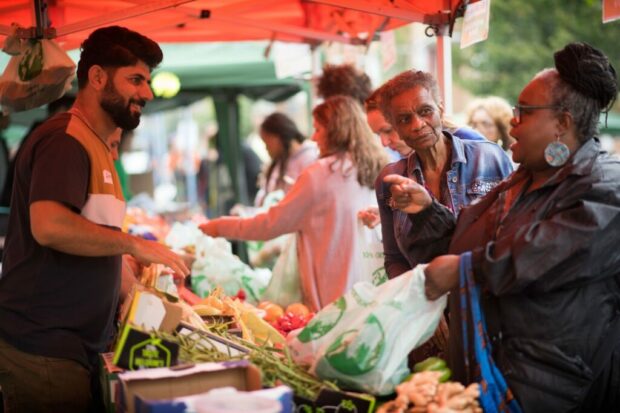
- How do we change the map of inequalities in our neighbourhood?
- What do we need to do differently to transform our neighbourhood?
- How do we build collaborations that shift power imbalances?
- How do we surface local issues and take action?
- How do we make sure our work is sustainable in the longer term?
These are all the questions that are central to our neighbourhood-based project We Walworth. Funded through Department for Levelling Up, Housing & Communities’ Partnerships for People and Place Programme, the project has been enabled through a partnership between Pembroke House (a local voluntary and community sector anchor organisation) and Southwark Council, and brings together a wide range of local people and organisations to collaborate on issues of food and inequality that matter to local people.
Since 1st April 2022, we have been working in partnership to develop a methodology to better understand local issues, and then work together as cross-sector teams to take forward the ideas that emerge.
We work together in person, in place as a group of residents, practitioners and professionals, including representatives of local and national government, bringing different skills, perspectives, connections and experience into the work. In six months, this is what we did:
- Hosted 8 events, attended by 320 attendees consisting of local and central government, local residents and local organisations
- Surfaced two local issues relating to food and inequality - the BBQs in Burgess Park which have been closed since before Covid, and the declining East Street Market - both issues are symbolic of wider systemic issues
- Convened 2 cross-sector ‘working groups’ where 15-20 people work together intensively to continue engagement and participate in a shared creative process
- Held over 1000 in-person conversations with local people
- Facilitated the creation of 2 collective visions to tackle the issues identified - shaped directly by the insights gained through engagement
We’re already demonstrating the potential and power of cross-sector collaboration, and we are developing the skills that will be needed to meet the challenges of the future. We’re modelling the council and central government as enablers, and a different kind of partner.
We’ve made a good start but we’ve still got work to do to persuade the wider system of the value of building relationships in place, and to unlock the capacity to work in a different way.
Why is ‘in person, in place’ so important?
The presence of public sector workers in neighbourhoods and their commitment to building relationships play a crucial role in fostering positive change. Evidence has shown that when public sector workers are physically present in communities, they demonstrate their dedication to understanding local challenges and engaging with residents on a personal level. This commitment builds trust, credibility, and a sense of genuine engagement, which in turn encourages open dialogue and the generation of new insights.
By actively listening to the concerns and aspirations of community members, public sector workers can gain valuable firsthand knowledge that leads to informed decision-making and targeted actions. This authentic engagement and relationship-building contribute to a deeper understanding of local needs and empower both residents and public sector workers to collaboratively address pressing issues and drive meaningful change.
Social entrepreneur Hilary Cottam OBE insists that we need to start outside our institutions if we want to find new answers and new insight: “changing systems to address the needs first requires asking the right questions of the right people, not top-down ‘service improvement’ within outdated constraints.”
How can senior policy shapers and makers, and those leaders who shape organisational culture embrace this new way of working? How can we unlock public senior leadership capacity into the neighbourhood in order to affect change? These are the tricky questions. Strong, genuine, public sector learning cultures are a good start. A greater risk appetite, an understanding of the benefits of experimentation and a more empowered workforce, with new metrics used to measure success will all help.
Imagine if one of the ways we measured the success of a public sector worker was through the answers to the following questions:
- Who do I meet most often in the service of my work?
- How many of those people are embedded in our communities?
- What changes have I made to our organisation / my service / my own working practices in response to the insight I have gained about ‘what works’ for local people?
Ultimately, our goal is to move from insufficient understanding to a more authentic truth. This requires un-learning and re-learning on an individual level and collaborating for system-wide change. The "in person, in place" approach allows us to notice differently, stand in relationships differently, and take action that contributes to a transformative journey for ourselves and our community.
Join our community
We use this blog to talk about the work of the multidisciplinary policy design community. We share stories about our work, the thinking behind it and what policymaking might look like in the future. If you would like to read more, then please subscribe to this blog. If you work for the UK's government, then you can you join the policy design community. If you don't work for the UK government, then join our AHRC Design and Policy Network.